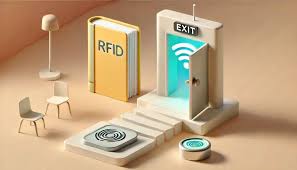In the digital era, library management systems have become more advanced, efficient, and user-friendly. One of the key components in modern libraries is the method used to track and manage books. Among the most commonly adopted technologies are barcode systems and Radio Frequency Identification (RFID). Both offer distinct advantages, but they also come with specific limitations. This article explores both options to help libraries make informed decisions.
Understanding Barcode and RFID Technologies
Barcode System
A barcode system is a machine-readable representation of data that is typically printed on labels attached to books. A barcode reader or scanner is used to retrieve information about the book from the library’s database. Each book gets a unique barcode that corresponds to its record.
RFID System
RFID uses radio waves to read and capture information stored on a tag attached to an object. An RFID tag contains a microchip and antenna, allowing it to transmit data to an RFID reader without direct line-of-sight. This technology can automatically identify and track books, even when multiple items are stacked or shelved.
Key Differences Between Barcode and RFID
1. Speed and Efficiency
- Barcode: Requires manual scanning of each item, one at a time, which can be time-consuming especially in high-traffic libraries.
- RFID: Multiple books can be scanned simultaneously, even from a distance. This leads to faster check-ins and check-outs.
2. Ease of Use
- Barcode: Simple to use and implement, but requires proper alignment of the scanner with the barcode.
- RFID: More user-friendly in the long run. Books can be scanned even when placed in a bag or stacked, which simplifies the process for both staff and users.
3. Durability
- Barcode: Labels are susceptible to wear and tear, fading, and damage over time, requiring frequent replacements.
- RFID: Tags are more durable and last longer, though they are more expensive.
4. Cost
- Barcode: Much cheaper to implement. Barcode printers and scanners are affordable, and barcode labels cost just a few cents.
- RFID: Involves a higher initial investment. RFID tags, readers, and software systems are costlier. However, costs have been decreasing with wider adoption.
5. Security
- Barcode: Offers basic identification and tracking but lacks advanced security features.
- RFID: Enhances security with features like anti-theft detection. RFID-enabled gates can alert staff if an item is taken out without proper check-out.
6. Data Capacity
- Barcode: Stores limited information — usually just an ID that links to the database.
- RFID: Can store more data directly on the tag, such as borrowing history or maintenance records, depending on the system design.
Pros and Cons
| Feature | Barcode | RFID |
| Cost | Low | High |
| Speed | Slow | Fast |
| Durability | Less | More |
| Security | Basic | Advanced |
| Implementation | Simple | Complex |
| Data Storage | Limited | Greater |
Which System Should You Choose?
The choice between barcode and RFID depends largely on the library’s budget, scale of operations, and long-term goals.
Go for Barcode if:
- You’re running a small to medium-sized library.
- Budget constraints are significant.
- You want a simple, low-maintenance solution.
- The volume of daily transactions is manageable.
Opt for RFID if:
- You manage a large or rapidly growing library.
- Your library handles a high volume of check-ins and check-outs.
- You’re seeking to improve security and operational efficiency.
- You have the budget to invest in advanced technology.
Final Thoughts
While barcodes remain a popular and cost-effective choice for many libraries, RFID offers significant advantages in terms of speed, accuracy, and automation. The decision should align with the library’s needs, user expectations, and available resources. As libraries continue to evolve into dynamic knowledge hubs, choosing the right technology will be key to delivering a seamless and efficient user experience.



